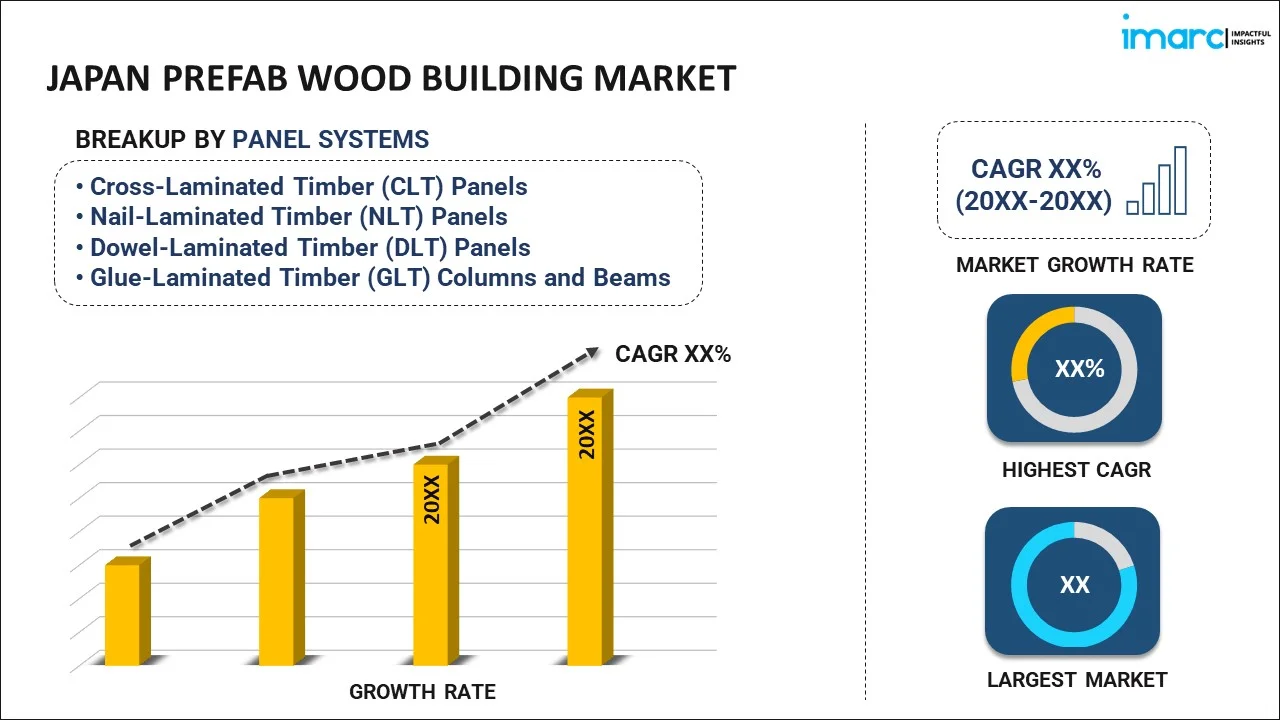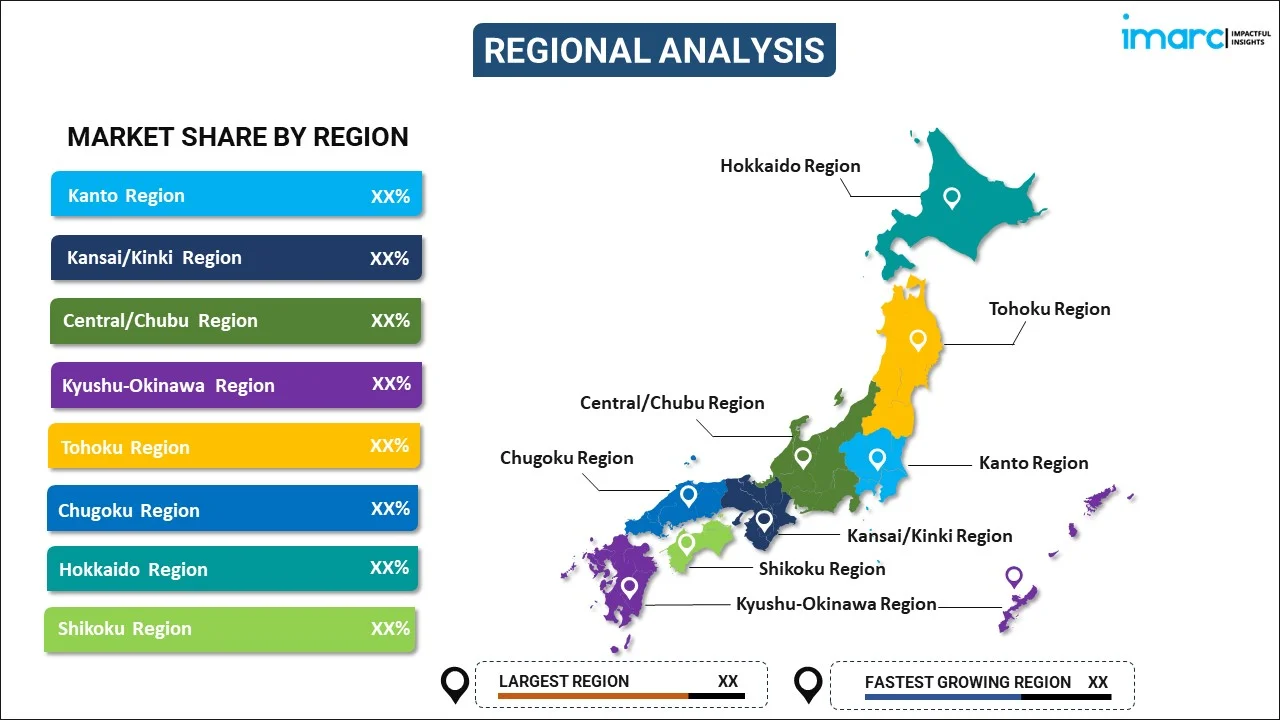
Japan Prefab Wood Building Market Report by Panel System (Cross-Laminated Timber (CLT) Panels, Nail-Laminated Timber (NLT) Panels, Dowel-Laminated Timber (DLT) Panels, Glue-Laminated Timber (GLT) Columns and Beams), Application (Residential, Commercial, and Others), and Region 2025-2033
Market Overview:
Japan prefab wood building market size reached USD 2.1 Billion in 2024. Looking forward, IMARC Group expects the market to reach USD 4.1 Billion by 2033, exhibiting a growth rate (CAGR) of 7.03% during 2025-2033. The increasing urbanization and population growth in Japan, coupled with the growing demand for eco-friendly construction materials and methods, is primarily driving the market.
|
Report Attribute
|
Key Statistics
|
|---|---|
|
Base Year
|
2024 |
|
Forecast Years
|
2025-2033
|
|
Historical Years
|
2019-2024
|
| Market Size in 2024 | USD 2.1 Billion |
| Market Forecast in 2033 | USD 4.1 Billion |
| Market Growth Rate (2025-2033) | 7.03% |
A prefab wood building, short for prefabricated wood building, is a structure constructed using pre-manufactured components that are manufactured off-site and then assembled on the building site. These components are typically made of wood, such as timber, plywood, or engineered wood products like laminated veneer lumber (LVL) and oriented strand board (OSB). Prefab wood buildings offer several advantages. They are cost-effective, as the standardized manufacturing process reduces material waste and labor costs. They are also quicker to build since many components can be produced simultaneously and assembled rapidly. Additionally, prefab wood buildings are environmentally friendly, as wood is a renewable resource with a lesser carbon footprint compared to other construction materials. These structures can range from small residential homes to large commercial buildings and can be customized to meet specific design and functional requirements. Prefab wood buildings have gained popularity due to their efficiency, sustainability, and versatility, making them a viable choice for various construction projects.
Japan Prefab Wood Building Market Trends:
The prefab wood building market in Japan has experienced robust growth in recent years, primarily due to several key drivers. Firstly, the growing awareness and emphasis on sustainable construction practices have propelled the demand for prefab wood buildings. These structures are inherently eco-friendly, as wood is a renewable resource and a carbon sink, aligning with the regional push towards greener building solutions. Furthermore, the need for rapid construction and cost-efficiency is another driving force. Prefabricated wood buildings offer shorter construction timelines compared to traditional methods, reducing labor and associated costs. This is particularly crucial in today's fast-paced construction industry, where timely project completion is paramount. In addition to this, the versatility of wood as a building material has contributed significantly to market expansion. Prefabricated wood systems can cater to various architectural styles and design preferences, attracting a broad customer base across residential, commercial, and industrial sectors. Moreover, government incentives and regulations promoting sustainable construction practices, including the use of prefab wood buildings, are expected to drive the market in Japan during the forecast period.
Japan Prefab Wood Building Market Segmentation:
IMARC Group provides an analysis of the key trends in each segment of the market, along with forecasts at the country level for 2025-2033. Our report has categorized the market based on panel system and application.
Panel System Insights:

- Cross-Laminated Timber (CLT) Panels
- Nail-Laminated Timber (NLT) Panels
- Dowel-Laminated Timber (DLT) Panels
- Glue-Laminated Timber (GLT) Columns and Beams
The report has provided a detailed breakup and analysis of the market based on the panel system. This includes cross-laminated timber (CLT) panels, nail-laminated timber (NLT) panels, dowel-laminated timber (DLT) panels, and glue-laminated timber (GLT) columns and beams.
Application Insights:
- Residential
- Commercial
- Others
A detailed breakup and analysis of the market based on the application have also been provided in the report. This includes residential, commercial, and others.
Regional Insights:

- Kanto Region
- Kansai/Kinki Region
- Central/ Chubu Region
- Kyushu-Okinawa Region
- Tohoku Region
- Chugoku Region
- Hokkaido Region
- Shikoku Region
The report has also provided a comprehensive analysis of all the major regional markets, which include Kanto Region, Kansai/Kinki Region, Central/ Chubu Region, Kyushu-Okinawa Region, Tohoku Region, Chugoku Region, Hokkaido Region, and Shikoku Region.
Competitive Landscape:
The market research report has also provided a comprehensive analysis of the competitive landscape in the market. Competitive analysis such as market structure, key player positioning, top winning strategies, competitive dashboard, and company evaluation quadrant has been covered in the report. Also, detailed profiles of all major companies have been provided.
Japan Prefab Wood Building Market Report Coverage:
| Report Features | Details |
|---|---|
| Base Year of the Analysis | 2024 |
| Historical Period | 2019-2024 |
| Forecast Period | 2025-2033 |
| Units | Billion USD |
| Scope of the Report | Exploration of Historical Trends and Market Outlook, Industry Catalysts and Challenges, Segment-Wise Historical and Future Market Assessment:
|
| Panel Systems Covered | Cross-Laminated Timber (CLT) Panels, Nail-Laminated Timber (NLT) Panels, Dowel-Laminated Timber (DLT) Panels, Glue-Laminated Timber (GLT) Columns and Beams |
| Applications Covered | Residential, Commercial, Others |
| Regions Covered | Kanto Region, Kansai/Kinki Region, Central/ Chubu Region, Kyushu-Okinawa Region, Tohoku Region, Chugoku Region, Hokkaido Region, Shikoku Region |
| Customization Scope | 10% Free Customization |
| Post-Sale Analyst Support | 10-12 Weeks |
| Delivery Format | PDF and Excel through Email (We can also provide the editable version of the report in PPT/Word format on special request) |
Key Questions Answered in This Report:
- How has the Japan prefab wood building market performed so far and how will it perform in the coming years?
- What has been the impact of COVID-19 on the Japan prefab wood building market?
- What is the breakup of the Japan prefab wood building market on the basis of panel system?
- What is the breakup of the Japan prefab wood building market on the basis of application?
- What are the various stages in the value chain of the Japan prefab wood building market?
- What are the key driving factors and challenges in the Japan prefab wood building?
- What is the structure of the Japan prefab wood building market and who are the key players?
- What is the degree of competition in the Japan prefab wood building market?
Key Benefits for Stakeholders:
- IMARC’s industry report offers a comprehensive quantitative analysis of various market segments, historical and current market trends, market forecasts, and dynamics of the Japan prefab wood building market from 2019-2033.
- The research report provides the latest information on the market drivers, challenges, and opportunities in the Japan prefab wood building market.
- Porter's five forces analysis assist stakeholders in assessing the impact of new entrants, competitive rivalry, supplier power, buyer power, and the threat of substitution. It helps stakeholders to analyze the level of competition within the Japan prefab wood building industry and its attractiveness.
- Competitive landscape allows stakeholders to understand their competitive environment and provides an insight into the current positions of key players in the market.
Need more help?
- Speak to our experienced analysts for insights on the current market scenarios.
- Include additional segments and countries to customize the report as per your requirement.
- Gain an unparalleled competitive advantage in your domain by understanding how to utilize the report and positively impacting your operations and revenue.
- For further assistance, please connect with our analysts.
 Inquire Before Buying
Inquire Before Buying
 Speak to an Analyst
Speak to an Analyst
 Request Brochure
Request Brochure
 Request Customization
Request Customization




.webp)




.webp)












